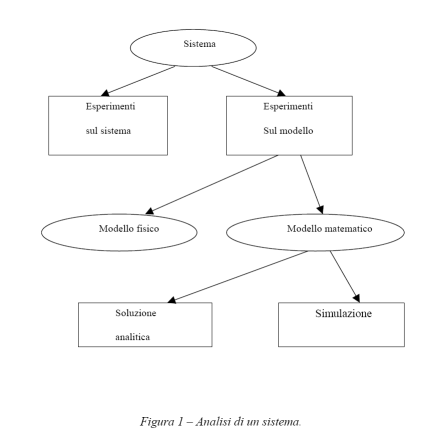1.2 Quantitative methods you for the productive systems analysis
In order to analyze a system and therefore to obtain usable information from the planner in order to improve the same one, it is necessary
to construct a model from being able to study.
The models can be physicists or matemati to us. In the study of the productive or logistic systems they come uses mathematical models you
to us that they represent a system through logical and quantitative relations; these relations come modified in order
to see as the model reacts and therefore as the system reacts.
If the mathematical model is simple can be studied analytically, obtaining therefore one exact solution.
If instead the model it is rather complex uses the simulation, since the analytical study would be much expensive
and difficult one.
In this case the model, called simulation model, comes codified using a programming language and comes
resolved numerically leaving from sure input in order seeing as the output are modified.
The fundamental factor that plays, therefore, in favor of the use of simulation techniques is constituted from the extreme flexibility
of employment, that an easy “modellizzazione” of real however complex systems concurs, escaping to ties and
to the simplifications you set up from the methodologies of analytical type.

One first classification of the mathematical models sees the stocastici distinction between determinist models and models to us.
In a determinist model not there are probabilistici elements, while these are present in a stocastico model.
Introducing the data of income in a determinist model a fixed result is obtained; in a stocastico model
instead they are introduced given problems and a problems result is obtained, that is an esteem of the real
characteristics of the model.
In the study of productive systems the choice of stocastici models often turns out necessary in order to hold account of one as an example series
of aspects of variability and unforeseeable legacies to the duration of the single operations (es. manual assembly),
to the temporal course of the material flows (traffic phenomena), to eventual phenomena of breakdown or malfunctioning, etc
The elevated complexity of the system, the existence of variable problems, the requirement to analyze the dynamic aspects
or of transitory, the necessity to hold account of eventual breakdowns or wrong operations force to address towards
“stocastici models of simulation”.
Also such models introduce some disadvantages; the employment of a simulation model only concurs to answer
to questions of the type what-if, that is to estimate the performances of the system to forehead of specific assigned configurations.
The planning process comes in such case to shape itself like a process for tried happened to you to you: beginning from
a limited range of progettuali alternatives is possible initially to confront, on the base of the obtainable performances,
the various configurations of the considered system and subsequently to explore, for those configurations that turn out
more convenient, the possible attainable improvements with various criteria of dimensioning or operating political
different.
This intrinsic limitation of the simulation techniques can partially be exceeded by means of the employment of opportune
methodologies statistics that concur to estimate, for an assigned configuration of the system, the main relations that
tie the variable progettuali with the variable ones of performance; it becomes, therefore, possible to exceed an approach
“for attempted to you” and characterizing with of progettuali choices that favor the optimal operation of the system.
An ulterior classification for the mathematical models to us regards the distinction between models of “continuous” type and models
of “discreet” type.
In the first case the characteristics of the system as an example endure changes of state of continuous type (the characteristics
of the fluid inside of process systems), in according to case the changes of state inside of the system are taken place
only in correspondence of discreet temporal intervals.
The simulation models consider you in the systems of material handling in the manifacturing industry are discreet, dynamic
and stocastici, and are call to you discret-event simulation model. In these models the variable ones of state can only change
in sure moments of time.
In these moments an event only can happen, term with which a whichever instantaneous event agrees that
can modify the state of the system.
